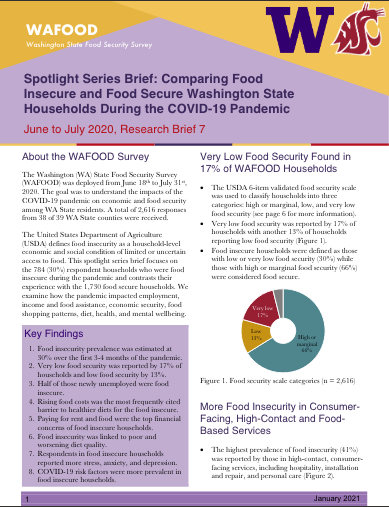WAFOOD Brief 7 – Comparing Food Insecure and Food Secure Washington State Households During the COVID-19 Pandemic
The United States Department of Agriculture (USDA) defines food insecurity as a household-level economic and social condition of limited or uncertain access to food. Published January 27, 2021, this spotlight series brief focuses on the 784 (30%) respondent households who were food insecure during the pandemic and contrasts their experience with the 1,730 food secure households. We examine how the pandemic impacted employment, income and food assistance, economic security, food shopping patterns, diet, health, and mental wellbeing.
Initial Findings
The USDA 6-item validated food security scale was used to classify households into three categories: high or marginal, low, and very low food security. Very low food security was reported by 17% of households with another 13% of households reporting low food security. Food insecure households were defined as those with low or very low food security. Half of those respondents who reported being newly unemployed were food insecure. Rising food costs was the most frequently barrier to healthier diets while paying for rent and food were the top financial concerns of respondents living in food insecure households. Respondents in food insecure households reported more stress, anxiety, and depression than those in food secure households. Food insecurity was linked to poor and worsening diet quality as well as greater prevalence of chronic conditions such as obesity and asthma.
Explore More: Find all briefs and publications related to this study on the project page.
Materials
Publication Date: January 27, 2021
Author(s):
Resource Type(s): Briefs
Research Area(s): Food Access
